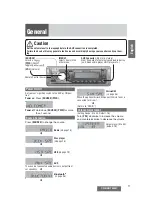
3
IM 77J01G01-01E
1st Edition
3. EXTERNAL WIRING
WARNING
●
To avoid the risk of an electric shock, turn off the
power supply and use a tester or similar device to
ensure that no power is supplied to a cable to be
connected, before carrying out wiring work.
●
Do not operate the product in the presence of
flammable or explosive gases or vapors. To do so is
highly dangerous.
●
Use of the product ignoring the specifications may
cause overheating or damage. Before turning on
the power, ensure the following:
•
Power supply voltage and input signal value
applied to the product should meet the required
specifications.
•
The external wiring to the terminals and wiring to
ground are as specifications.
Wiring should be connected to the terminals on the socket of the
product. The terminals for external connections are of M3 screws.
Use crimp-on terminal lugs for connections to the terminals.
•
Recommended cables: A nominal cross-sectional area of
0.5 mm
2
or thicker for signal cables, and that of 1.25 mm
2
or
thicker for power cables.
Wiring Diagram
10
11
3
1
7
8
9
Power supply
11
10
8
L
+
N
–
GND
Input
+
–
9
7
Output
1
3
V
±
CAUTION
●
Unused terminals should not be connected.
●
The power line and input/output signal lines should
be installed away from noise-generating sources.
Other wise accuracy cannot be guaranteed.
●
Make sure to earth ground the ground terminal
through minimum resistance. The length and
thickness of the grounding cable should be as
short and thick as possible. Directly connect the
lead from the ground terminal (terminal no. 8) of
the product to the ground. Do not carry out daisy-
chained inter-ground terminal wiring.
●
The product is sensitive to static electricity;
exercise care in operating it. Before you operate
the product, touch a nearby metal part to discharge
static electricity.
●
If the ambient temperature is 50 °C or more, please
use the cable that the rated temperature is 70 °C or
more.
4. MAINTENANCE
The product starts running immediately when the power is turned
on; however, it needs 10 to 15 minutes of warm-up before it
meets the specified performance.
4.1 Calibration Apparatus
•
A AC voltage current standard (YOKOGAWA 2558A or the
equivalent)
• A digital multimater (YOKOGAWA DM7560 or the equivalent)
•
A precision resistor of 250 Ω ± 0.01%, 1 W
4.2 Calibration Procedure
1.
Connect the instruments as shown below. First adjust the
output-1 signal and then the output-2 signal.
10
11
3
1
7
8
9
Power supply
11
10
8
L
+
N
–
GND
1
3
Input
AC voltge
current
standard
R: 250
Ω
precision resistor
for current output
DMM
7
9
Output
R
+
–
V
±
2. Use the AC voltage current standard and apply input signals
equivalent to 0, 25, 50, 75, and 100% of the input span to the
product.
3. Check to see the corresponding output voltages are 0, 25, 50,
75, and 100% respectively and within the specified accuracy
rating. “R” is used for current output.
• If the output signals are out of the accuracy rating range,
adjust the output signal level using the zero and span
adjustment volumes on front face of the product.
Zero-adjustment volume
Output
Span-adjustment volume






















